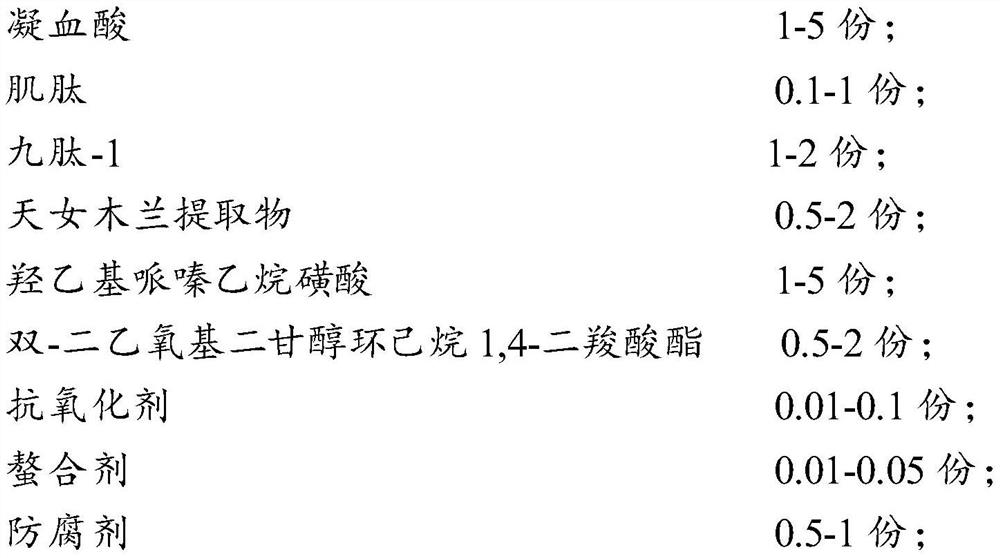Whitening composition aiming at sensitive skin and application thereof
A sensitive skin and whitening technology, applied in the field of skin care products, can solve problems such as poor use effect, high irritation, and poor product stability, and achieve good whitening effect, high safety, and the effect of inhibiting inflammatory reactions
- Summary
- Abstract
- Description
- Claims
- Application Information
AI Technical Summary
Problems solved by technology
Method used
Image
Examples
Embodiment 1-4
[0037] According to the formula in Table 1, prepare the whitening composition product respectively:
[0038] Heat water, butylene glycol, p-hydroxyacetophenone, and 1,2-hexanediol to mix and dissolve in advance, heat to 80-85°C, then add tranexamic acid, EDTA.2Na, and hydroxyethylpiperazineethane in sequence Sulfonic acid, after stirring evenly, add carnosine when the temperature drops to 60°C, add Magnolia extract, bis-diethoxydiethylene glycol cyclohexane 1,4-dicarboxylate when the temperature drops to 45-50°C Ester, nonapeptide-1, and sodium bisulfite were stirred evenly to obtain a whitening composition product. The pH of the whitening composition is 6.0-6.8, and the appearance of the product is a colorless transparent liquid.
[0039] The specific proportions and pH values of each formula are as follows. Examples 1-4 correspond to groups 1-4 in turn, and CK is the formula without the whitening active ingredient.
[0040] The prescription (unit: wt%) of table 1 embodim...
Embodiment 5
[0045] Experiment 1. Stability verification
[0046] Put the composition products made by groups 1-5 and CK in the present invention under the conditions of room temperature, refrigerator (-10°C) and oven (45°C) respectively, according to 0 day, 3 days, 7 days, 15 days, Stability inspection was carried out in 30 days to observe whether the products of each composition had precipitation and delamination.
[0047] The result is as follows:
[0048] Table 3 Stability test results
[0049]
[0050] The results showed that the stability of the products of each group of compositions was good (normal: no precipitation and delamination).
[0051] Experiment 2. Sensitive skin tolerance efficacy test
Embodiment 3
[0052] Get embodiment 3 and carry out sensitive skin tolerance efficacy test;
[0053] Experimental population: 120 subjects, all of whom are female aged 20-50, in good health, without taking drugs, and in line with the voluntary selection criteria for subjects.
[0054] Test method: A dermatologist conducts a clinical assessment of the subject's facial skin to determine that the subject has sensitive skin. The subject applies the composition product to the cheeks once a day in the morning and evening (each application is about 0.5 drops of 10 drops). ml), when the subject applied the composition product on the 3rd day and the 7th day, observe and record the tolerance of the cheek skin of the subject.
[0055] Clinical Observation Index
[0056] Clinicians evaluated the observation indicators before treatment, on the 3rd day and 7th day after treatment. Evaluation content of objective indicators: erythema, desquamation, evaluation content of subjective indicators: dryness, i...
PUM
 Login to View More
Login to View More Abstract
Description
Claims
Application Information
 Login to View More
Login to View More - R&D
- Intellectual Property
- Life Sciences
- Materials
- Tech Scout
- Unparalleled Data Quality
- Higher Quality Content
- 60% Fewer Hallucinations
Browse by: Latest US Patents, China's latest patents, Technical Efficacy Thesaurus, Application Domain, Technology Topic, Popular Technical Reports.
© 2025 PatSnap. All rights reserved.Legal|Privacy policy|Modern Slavery Act Transparency Statement|Sitemap|About US| Contact US: help@patsnap.com



